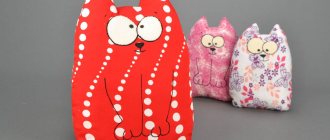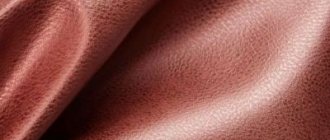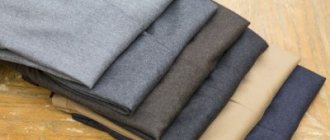Today we will not compare the characteristics of new and old generation faux fur and designate them differently, as I did in a very detailed introductory article about Eco-fur. So by both Eco-fur and faux fur, I will mean new generation fur. This is an article about it and in it I will tell you why you should not worry about caring for this new material, I will give answers to popular questions and a bunch of other useful tips on washing, drying and storing Eco-fur.
Author of the article: Hostess.
My name is Natalya and I have been managing my home professionally for more than 15 years. Saving my extended family's favorite things; I protect our house from fleas, midges, bloodsuckers and other rodents; I find faithful electronic assistants in household chores. And I am happy to pass on this entire experience to you)
Do you also want to become a Hostess on our blog? There's enough room for everyone! Just write to us via the “contact” form)
Eco-fur suits everyone!
As always, when a new high-tech material appears, people treat it with suspicion. And if the humane method of producing Eco-fur and its “natural” appearance pleases people who care about the environment, then many questions arise about washing a blanket or fur coat made of faux fur.
How to wash Eco-fur in a washing machine.
Yes, faux furs can be machine washed and this is a big relief for everyone. The ability to be washed gently is a huge plus of this fabric. The main thing is to follow simple rules.
- Before washing a fur coat or shaggy pillowcase - get rid of dust. Take a bamboo stick or a carpet beater; you can also use a simple soft brush. Do not be overzealous so as not to knock the fur out of the product along with the dust. Of course, this should be done not in the apartment - you don’t want to inhale dust and small hairs and then collect it all over the apartment. It's best to do this outside.
I came across recommendations Place fur side down on a sheet and beat out. You can do this, but in my opinion it is less effective. Dust will not go anywhere from the house and you still need to shake out the sheets later. Double work.There is another good way - turn on the vacuum cleaner at low suction power, and vacuum the product strictly along the pile with a nozzle for upholstered furniture.
- Then soak for 15-20 minutes in a bowl of warm water, having previously diluted the delicate wash gel there. Do not leave the fur in contact with water and detergents for a long time - it does not like this.
- Ruffle the fur coat a little in the basin and let the water drain a little, then put it in the washing machine. The available pre-soak wash cycle in the machine eliminates hand soaking. You can immediately put a dry product into the machine.
- If you have a “delicate” mode or modes for silk, wool, turn them on.
Delicate mode only! If this is not the case, set it to 30-40 C (no higher!), short wash (express) and turn off the spin cycle. These actions will prevent possible deformation and shrinkage of the material. - After the machine has finished working, remove the product and hang it to drain . Place small items on a wire rack or in a clean sink, place outerwear on hangers and hang them over the bathtub.
⚠️ Remember that the spin must be turned off! I read that some people wring it out, but then there’s more fuss with drying and straightening the broken pile, so don’t complicate your task.
The item has been washed. About drying below)
Dry cleaning
There are times when improvised means are not enough. If the dirt cannot be removed by home methods, you should use dry cleaning services. Professionals will be able to thoroughly clean the product and restore it to its original beauty and shine. Whether it is possible to clean clothes with chemicals is another question. Typically, information about acceptable procedures is indicated on the label.
How to wash faux fur by hand.
- The first stage of cleaning from dust and soaking in soapy water is exactly the same as for machine washing.
- If the item is small, gently “swirl” it in the basin and squeeze it lightly. If it’s a fur coat or a blanket, pour a bath - any size will fit in it. Press the large item to the bottom so that it is completely wet.
- Eco-fur is a delicate fabric, so be gentle with it. You cannot rub the fur like regular underwear , otherwise the lint may creep in. Rub gently with a soft brush or hand, paying particular attention to areas that are more heavily soiled - bottoms, pockets, sleeves and the inside of the collar.
- Rinse the product in several waters . First use the same warm as when washing, then cooler and finally cold. There should be plenty of water to thoroughly wash away cleaning agents and remaining dirt. Actively use the tap or shower; running water will perfectly remove all excess from the matter.
- Remove the item from the water and let it drain thoroughly, in the same way as after machine washing. a couple of teaspoons of vinegar to the last rinse water .
- You can’t wring out faux fur , otherwise you can ruin the base by “twisting” it and breaking the pile. After the main water has drained, wrap the product in a towel and press lightly - most of the moisture will go into it, drying will be faster. You can skip this stage - let the item hang, drain and dry on its own.
- If a small area , there is no need to wash the entire item. Dilute washing powder or washing gel in a liter of water (shampoo is also suitable), stir well and wipe the dirty area with a sponge soaked in a soapy solution. Afterwards, rinse the treated piece under running water.
How to clean without washing?
Baking soda allows you to remove small stains without getting the item too wet.
Wet cleaning using external solutions is an effective way to combat and remove stains of varying complexity. Basically, this approach has worked well for cleaning collars, hats or small elements on larger items.
The simplest solution is cleaning with starch or soda. You should take 150-200 grams (depending on the contamination) and thoroughly treat the stain. It is important that the absorbent completely penetrates between the pile, right down to the base.
Next, the treated item is left for 20-30 minutes, after which you will need to remove particles of soda or starch. First, the product is turned over and shaken. Next, take a soft brush and comb out the remains.
A mixture of 1 teaspoon of gasoline/alcohol with 1 tablespoon of starch is good for removing greasy and greasy stains. The proportions can be adjusted until a viscous mixture is obtained. The resulting paste is applied to the stain and left for up to 10 minutes. Afterwards it is removed with a cotton swab and combed out with a brush.
How to properly dry a product.
- To prevent the fur from being high with “icicles” or with “creases” after washing, it must be fluffed. While drying, carefully comb the fur along the pile with a brush with sparse rounded teeth. Do not go too deep into the material, so as not to snag and damage the base. Superficial movements will be enough to smooth and straighten the pile on the collar or straighten the faux fur on the hood. A slicker brush for cats or dogs , which can be purchased at any pet store, is best suited for this purpose
- Dry the product away from heating devices, do not use a hair dryer so as not to damage the fiber.
- Hang your outerwear on hangers in a well-ventilated area . It will take longer to dry in the bathroom, because there is a lot of moisture there.
- Never dry Eco-fur in the dryer. High temperature is death for synthetics . 99% of the time, after this it will only be possible to use it in handicrafts in parts or give it to children as toys, because the pile will deteriorate, stick together, and the base will shrink.
Comb gently and carefully
⚠️ To the direct question - is it possible to iron Eco-fur, I will answer directly - no! Steaming and ironing, even through gauze, is also prohibited. Faux fur is afraid of high temperatures from any source. If the pile has become wrinkled, wet it (preferably with a spray) and comb it, it will “sag” and smooth out.
What mistakes to avoid
- You should not wash or clean your fur coat using very hot water, as it can shrink a lot.
- You should not dry your fur coat in the open rays of the sun, or near heating devices.
- A fur coat should never be ironed, even from the lining side! When drying, the washed fur coat must be straightened on hangers, giving it its original appearance. Wet flesh perfectly takes the given shape, so the fur coat does not need ironing or steaming.
- Drying a fur coat after washing, cleaning, as well as when wearing it after rain and snow, is necessary only on strong hangers, and not on ropes - it can become deformed.
- If the fur coat is already quite old, its cleaning and washing should still be entrusted to dry cleaning, because the fur can be damaged by water and detergents.
Dry cleaning of Eco-fur at home and getting rid of odor.
If you are not sure that your product can be washed or this is directly stated on the manufacturer’s label, use these simple methods for caring for an Eco-fur coat.
Method one - minimum moisture.
- Lather a spoonful of shampoo (no conditioner!) or delicate wash gel in a glass of warm water.
- Hang your parka or sheepskin coat on hangers over the bathtub and wipe the fur with a sponge and foam.
- As a “rinse”, run along the pile with a clean, damp sponge.
- Comb gently and dry completely naturally.
Method Two - completely dry
We will need a small package of starch or flour.
- Place a faux fur collar or hat on a rack over the bathtub and sprinkle the product liberally onto the fur.
- Rub gently with your hand so that the powder penetrates everywhere. Leave the item for 5-10 minutes until the starch or flour absorbs the dirt along with the unpleasant aroma. Then gently shake out and comb out any remaining residue.
- Finally, to remove dullness after cleaning, wipe the fur with a sponge soaked in slightly warmed glycerin (to make it thinner). The fur will be shiny and iridescent.
By the way - here's a great life hack - dry shampoo for people or animals . And it will remove dirt and smell. Buy at hairdressing salons or pet stores.
The third method is frosty.
|
|
This is a very effective method for wool and eco-fur. On a frosty day when pure white snow has fallen , go for a walk with a blanket or fur coat. Place them on the snow and sprinkle them generously, gently rubbing them with your hands . Do several "procedures". Shake off the snow. At home, dry and comb. No dirt, no smell)
Dry cleaning
The dry cleaning method for pile products involves dry or semi-dry treatment of fur with various substances. These can be ready-made stain removers that are sold in stores. Usually it is written on them what types of fabrics the product is suitable for; a separate type is sold for fur. And also check whether the composition matches the color of the item (it could, for example, be bleaching, you need to keep an eye on this).
An analogue of the purchased product can be prepared at home. For minor stains, dry cleaning is suitable, during which you can slightly refresh the color of the fur and remove the unpleasant odor. For this purpose, bulk products are used, such as:
- starch;
- sand - please note that it must be cleaned, construction sand will not work;
- semolina;
- crushed chalk;
- salt.
Starch and semolina are used for any type of contamination. Salt helps remove grease stains - its crystals absorb fat. Powdered chalk, in addition to cleaning, allows you to slightly bleach the fur, so it is more rational to use it for light-colored products. Sand, on the contrary, is better used for colored fur, because it may not be clean enough and make white fur yellowish.
If you are unsure that the composition of the home remedy will suit the fur structure of your product, then it is better not to risk it. It would be best to give the item to specialists so that they can clean it. Special establishments have equipment and proven substances that will help the product regain the appearance it had after purchase.
Housewives, after washing their fur coats at home, leave reviews on how they did it. This is real, but deep cleaning, the same as that carried out in specialized institutions, is difficult to do.
A little about the features of handling white Eco-fur.
in the middle of the article
Most of all, brides are worried that on their wedding day the white faux fur cape will not disharmonize with the white dress. White is white - it always gets dirty faster than dark and sometimes turns yellow. This can also happen due to the wrong choice of detergent. To get rid of yellowness on Eco-fur and whiten it, use these methods of lightening faux fur .
May be useful: How to care for a white (light) down jacket so that it lasts longer.
So, if washing in the machine did not help, dilute freshly squeezed lemon juice with water 1:1 and rub it along the pile of your white fur coat. Do this slowly and carefully to work through every little bit of hair. Lemon is an excellent natural bleach that is completely safe for synthetics.
⚠️ It is not recommended to use citric acid to clean faux fur.
A more powerful remedy consists of hydrogen peroxide, ammonia and water in equal proportions. The steps are the same - thoroughly wipe the white fur and dry it. Pre-test the solution on an inconspicuous area of the item to avoid unpleasant reactions.
Detergent
Can faux fur be washed? Can. Such a product can be processed manually, cleaned using home or professional products.
It is better to use specially formulated chemical products designed to remove dirt from artificial pile.
Manufacturers of such products recommend using the following products:
- FLAT;
- VESTAR (washing gel);
- Emsal Tuba;
- Alles Gut;
- Dreft Delicates&Color;
- Luxus Professional;
- Frosch.
All detergents will provide a delicate wash, show good results, retain the shape of the product and protect the color from fading.
Proper storage of eco-fur products.
Usually, warm eco-fur coats are sent “on summer vacation”, sometimes fluffy pillowcases and faux fur blankets are replaced with something lighter. What can you do to avoid pulling out something matted and shapeless from the cache next winter?
- Moths do not like eco-fur made from synthetics. But if your product contains natural fibers or it has not been washed, then she may well feast on natural fibers or what is left on the product from you - particles of skin, fat. Hence a very important rule - before you put the item away for storage, you need to wash it and, after drying, treat it with moth repellents. Place dried orange or lemon slices in the cupboard - this should repel harmful insects. By the way, don’t forget to check the cabinet itself before doing this - what if the moth is already sitting there and waiting for something tasty? Clean and ventilate it to drive out any unwanted “guests.”
- Never fold vests or fur coats in piles, do not roll them into rolls - you will inevitably wrinkle the pile. It’s better to immediately put on a ready-made jacket and go for a walk without fiddling with straightening it out. With blankets, folding is impossible to avoid, but creases can be easily fixed with water later. It's not difficult, it just takes time. Try to fold a large item as few times as possible.
- Hang the clothes on hangers, comb them and pack them in a special case so that they do not come into contact with other clothes in the closet, and do not lose or wrinkle the “fur”. It would be good to put the blanket in a paper bag separately from other products.
Is it possible?
If the faux fur gets dirty, you can wash it. Most products tolerate such treatment well and do not lose their attractiveness.
Conditions to be observed:
- Study the information indicated on the label. The manufacturer's recommendations should not be violated.
- If the fur comes off, it is better to remove it and wash it separately from the main product.
- Before you start washing, the item must be cleaned of dust and other contaminants. To do this, use a low-power vacuum cleaner or a soft-bristled brush.
- Washing fur items together with other items is unacceptable.
- If there are minor stains on the fur, do not wash it completely. Limited to local treatment of stains.
- Preference is given to hand washing.
It is not recommended to machine wash long faux fur, but the shorter it is, the lower the risk of damage. You should not experiment with fur trim of questionable quality.
If the product has become dusty after winter, then simply knock it out. A bamboo rod is used for this. First, they process the item from the wrong side, and then from the front side.
Then the pile is combed. This will give it freshness after a long stay in the closet.
Tips and recommendations for wearing and caring for products made from Eco-fur.
- Don't forget to check your pockets and fasten all buttons and zippers before washing.
- Instead of washing powders, it is better to use gels - they dissolve better, wash out better and do not leave “crumbs” or streaks. If at the moment there is only powder, check that it is completely dissolved.
- Be sure to use products designed for synthetics . They do not contain aggressive substances that can corrode the hairs and the base of Eco-fur.
- If a fur coat or blanket becomes electrified, use antistatic agents and special anti-static gels for washing synthetics, this will save you from “electric shocks.”
- Clean faux fur items separately from other items . Wash the jacket and the fur on it separately. On many models, the fur (or hood with fur) is detachable. You most likely won’t be able to clean a parka with fur this way and will have to wash them together.
The fur must be washed separately if it is detachable.
- Do not use stain removers, chlorine bleaches or other components that are aggressive to synthetics, including acetone. Only special products for synthetic delicate fabrics or harmless folk ones - “grocery products”.
- Try to wash the product once or twice a season, no more . Less contact with water and detergents will increase the service life of a fur coat or fur jacket.
- Pay close attention to the manufacturer's information on the product label . Perhaps washing is not shown for this particular fur, and instead you will see a dry cleaning icon. Dry cleaning will also help you with very complex or severe stains.
- Brush your coat regularly to avoid matting.
- Avoid carrying bags on your shoulder or sleeve. At least change the shoulder so that the fur does not wear out. Be careful when wearing backpacks.
- If you are caught in snow or rain while wearing a fur coat or hat made of Eco-fur, shake the product at home, remove any remaining moisture with a clean cotton cloth along the pile, comb it carefully, and leave to dry naturally .
As you can see, caring for eco-fur coats is quite simple. It is no more difficult to care for natural fur, and the animals do not suffer .
All you need to do is treat faux fur with care and soul - and your rugs, pillows and clothes will remain with you unchanged for a long time. And if you still manage to do something wrong with it, try painting Eco-fur, thereby making an attempt to revive it.
Who has experience in owning and cleaning faux fur products? Share secrets, recommendations and proven methods in the comments)
And a short video demonstration on how to wash a fur coat made of eco-fur... or any other product made from it. The brand doesn't matter, it's just an example.
The text is completely original. Copying any elements of the article is possible only with an active link to the source!
Process Features
The next question that will puzzle the owner of synthetic outerwear is how to wash a faux fur coat. Fur outfits are tidied up both manually and in an automatic machine. The main thing to remember is some features of the products:
- Washing in hot water will distort the fabric. The pile will become disheveled and lose its original shine.
- Drying should be done away from heat sources - warm air makes the pile brittle.
- There is no need to repeatedly wash outerwear; it is better to partially clean it.
- Washing powders are harmful to fluffy beauty - unnatural skins deteriorate from frequent exposure to foam detergents.
- You cannot rub the material when washing - bald spots will appear.
Cleaning the entire faux fur coat
If your fur coat has become dusty and has acquired a worn-out appearance, you can easily restore its beauty at home using a soap solution. To prepare the cleaning product you will need: a large basin, delicate shampoo or liquid hand soap, a foam sponge or soft brush, a cotton napkin, a bath towel. Procedure:
- lay the fur coat on a flat, hard surface or hang it on a hanger;
- pour warm water into a basin (no more than 30 °C), add soap or shampoo and stir well until a large amount of foam forms;
- dip a sponge or brush into the foam solution and process the product in the direction of the fleecy part;
- upon completion of treatment, remove any remaining soapy liquid with a cotton cloth soaked in water;
- blot the wet fur with a terry towel and smooth the pile;
- dry your fur coat naturally, without resorting to electrical appliances and batteries;
- comb the pile after the item has completely dried.
Dry cleaning
Dry cleaning is the most gentle method of care. It can be applied to both natural and artificial coats.
You can follow this method: attach a special attachment to the vacuum cleaner for cleaning clothes. Use it to methodically process the product from top to bottom. This cleaning must be done both from the front and from the inside.
Natural
If there are greasy stains on the topcoat, they should be treated separately. It is better to act as follows:
- Sprinkle the area with greasy marks with talcum powder or starch.
- Rub in lightly.
- Clean off the surface with a brush.
- Repeat the treatment several times.
Individual worn areas can be restored using a regular office eraser. Another option is to use a brush with rubber bristles, which can be lightly moistened with ammonia.
Dirty areas on a leather sheepskin coat can even be wiped off with semolina. To do this, you need to follow the following algorithm:
- Put a glove on your hand.
- Take a small amount of cereal in your palm.
- Rub the stained area.
- Shake off any remaining cereal.
- Repeat processing.
The video will show you how to clean a sheepskin coat using semolina:
Artificial
Stains and localized dirty areas can be cleaned without doing a full wash. As with natural sheepskin, you can use talc or starch.
These substances have the property of absorbing fat, so they can be used in cases of greasy conditions, such as sleeves or pockets.
Starch is poured onto the stain so that it is completely covered and left for several hours. After the used powder is cleaned off, the manipulation is repeated. Finishing with a vacuum cleaner will help remove remaining starch.
Rules for washing a fur collar
Expensive cashmere jackets and coats are decorated with natural pile, but down jackets are complemented with artificial pile. Before using one or another method, make sure what the outerwear item is made of. In case of an error, there is a risk of leaving the item without decoration.
Natural and artificial fur can be cleaned at home in different ways: dry, with water and soap, with steam, or with a specialized treatment agent.
Handwash
Suitable products from which you can whip up a good strong foam:
- ordinary laundry or bath soap;
- shampoo;
- dishwashing detergent;
- animal shampoo;
- washing powder;
- a product for cleaning fur collars and other elements.
If the collar is not removable, there is no zipper, Velcro, buttons or snaps, it will have to be cut off. It happens that synthetic fur is built into the fabric. You need to take the item to the dry cleaner or try to wash the item of clothing at home without getting the fur collar wet or damaging it.
Soap and ammonia
Dilute soap in warm water, add a few drops of ammonia. Apply the solution to the edge of the fur collar, wait, and then try to pull. If it is deformed, it cannot be washed, otherwise there will be unpleasant consequences for the appearance. Use dry cleaning. If nothing happens to the synthetic fur, you can immerse it in water and lightly wash the collar.
You cannot rub or wring out a fur item too much. It may become deformed.
The washed wet item is shaken and laid out on the fabric. The top of the pile is blotted with paper napkins and towels. Fur items cannot be dried on a radiator at home, ironed, or hung on a rope.
When there is no ammonia, a foam solution is used. A faux fur item is moistened with a cotton swab or dishwashing sponge, rubbed several times over contaminated areas, and then treated with clean water.
Hydrogen peroxide
To remove yellowness from the pile, use hydrogen peroxide:
- Dilute peroxide in cold water;
- apply to a sponge or cotton pad;
- go over the growth of the pile several times;
- remove the remaining solution from the fur collar with a paper napkin or terry towel and let it dry.
Designers and clothing manufacturers indicate the composition of the product. If there is information on the label that the collar of a sheepskin coat or down jacket is made of synthetic material, then you can use a washing machine. Such items are washed in a gentle automatic mode at home on program 400 using liquid detergent, do not wring out.
Wet cleaning
The steam generator is carried out several times along the growth of the fur at a distance of 20 centimeters from the lying fur collar. It is shaken and left to dry in a well-ventilated area.
You can clean it at home using a brush moistened with plain water. It is carried out in the direction of the pile. Use a dry towel to remove any remaining moisture. The fur collar is dried in a horizontal position. This method allows you to remove dust and refresh the appearance of a fur collar, but does not remove greasy stains.
Dry cleaning
Natural fur cannot be washed or washed at home. To process such products, products that do not require water are used.
A collar made of mink, arctic fox, sable, raccoon, and silver fox cleans starch well. Take a handful and lightly spread it over the pile. When the starch darkens, the product must be shaken and repeated as many times as possible until the powder stops changing color, and ventilate.
River sand will help you clean beaver or nutria fur at home:
- Heat the sand in the microwave or oven, rub it into the pile with light circular movements.
- Leave to cool.
- Shake and brush through the fur with a clothes brush.
- We ventilate.
The rabbit skin collar is cleaned with chalk, talc, baby powder, rye or oatmeal. We rub the suggested products into the fur item and shake it. Residues are removed with a brush in the direction of growth of the pile, then against it. If the product is gray in color, it is worth repeating the treatment of the fur collar at home.
Starch works great on makeup stains. Lipstick and foundation remain on the absorbent.
You should not vacuum a fur collar at home to remove particles of flour, starch or other cleaning agent. The vacuum cleaner damages the fluff.
The astrakhan collar is not combed. You need to shake it sharply.
Wet cleaning instead of washing
When processing a product wet, it is important to avoid getting the core (the underside of the skin) wet. If this happens, then after drying it becomes rough and deformed.
Therefore, use a thoroughly wrung-out napkin (gauze, cotton cloth) or sponge.
To clean heavily soiled areas, you can use the following products:
- soap solution;
- ethyl or ammonia (ammonia);
- salt;
- table vinegar;
- glycerol;
- lemon juice;
- hydrogen peroxide.
The last remedy is considered the most aggressive, so using it on dyed fur is risky.
Soap solution
To prepare a soap solution, you will need water and something foaming (washing powder, shampoo, baby soap, carpet cleaner).
It is necessary to dilute any of the listed detergents in an amount of 40–50 grams in a liter of warm water. With intensive stirring of the solution, a strong foam should be obtained.
Then a sponge is moistened in the resulting liquid and the fur surface is treated. Remains of foam are cleaned off with a brush dipped in cool water.
If you clean dyed sheepskin, choose a washing powder without a bleaching effect. This does not apply to white fur.
Vinegar and alcohol
A mixture of alcohol and vinegar will help get rid of greasy stains. It is necessary to combine the following ingredients in equal proportions:
- 10% ammonia;
- table vinegar;
- water.
Mix thoroughly and soak a cotton swab or disk with the solution
They go over the entire surface of the fur coat, paying special attention to the most contaminated areas.
Then wipe the fur with a clean, damp cloth and place the item on hangers to dry.
Hydrogen peroxide
Hydrogen peroxide effectively removes greasy shine, yellowness and greasy stains. The recipe for the cleaner is simple.
You need to take 500 ml of water and add:
- 3 tbsp. l. table salt;
- 5–6 ml of hydrogen peroxide.
This option is especially relevant for fur coats made of white and light sheepskin.
Ammonia
A dark mouton fur coat can be cleaned with ammonia. It is mixed with cold water in a ratio of 1:4.
Then dip a sponge or piece of fabric into the solution and carefully begin to process the fur product.
Even if the fur coat is not very dirty, this recipe will be useful for adding freshness and shine.
After the end of the winter season, it is recommended to use this method before putting the fur coat in the closet for summer storage.











